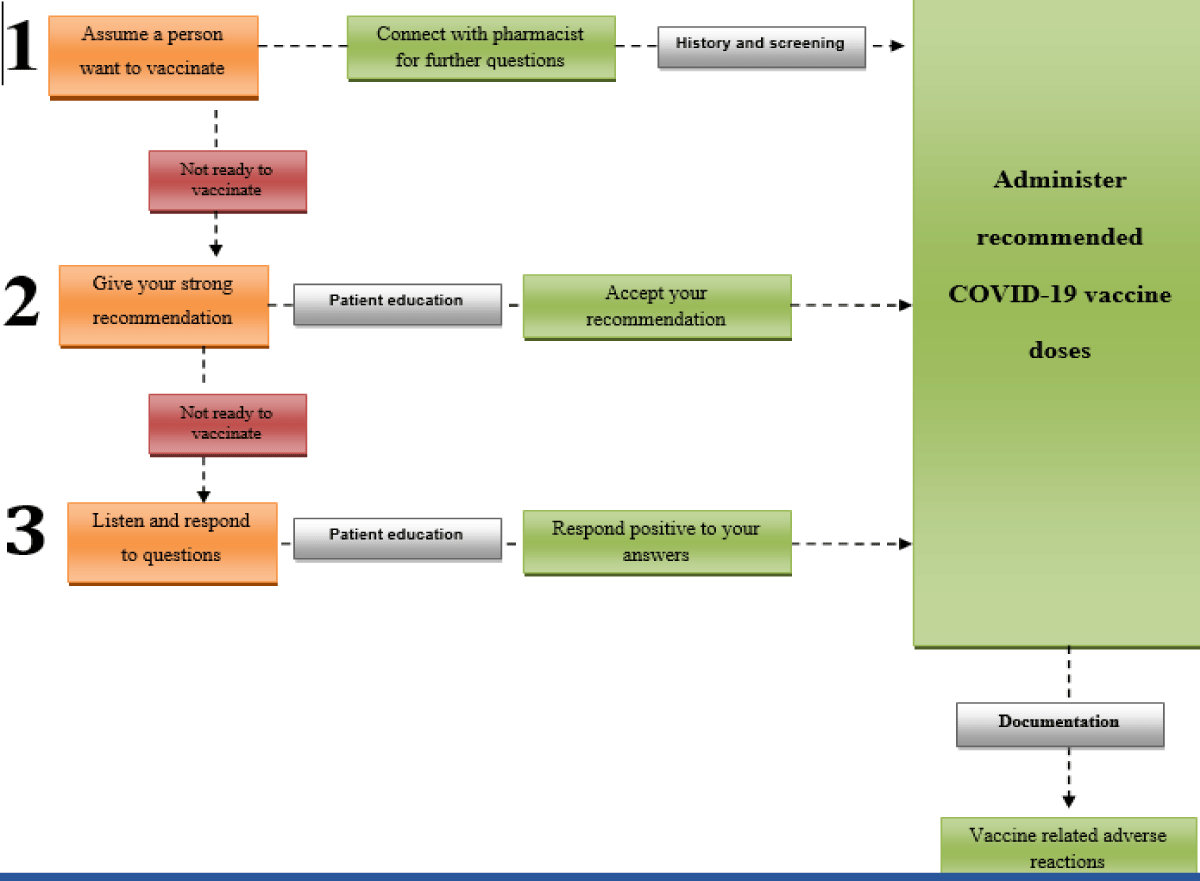> Medicine Group. 2021 Apr 21;2(4):288-291. doi: 10.37871/jbres1227.
COVID-19 Vaccination and the Expanding Role of Pharmacists: Pharmacist - Immunization Program
Muhammad Ahmer Raza1,2, Shireen Aziz3,4, Shahid Masood Raza1,4,5* and Sana Shahzad4
2Department of Clinical Pharmacy, School of Pharmaceutical Sciences, Shandong University, Shandong, China
3School of Pharmacy, Zhengzhou University, Henan, China
4Faculty of Pharmacy, University of Sargodha, Pakistan
5School of Pharmacy, Tongji Medical College, Huazhong University of Science and Technology, Hubei, China
- Pharmacist
- Immunization
- Vaccination
Abstract
Pharmacists in health systems involved with immunizations have used their practice settings to become advocates for immunization and increase their responsibilities in the public health monarchy. Administering vaccines to patients and health care workers is enabling some health-system pharmacists to assume a prominent role in public health. Pharmacists have noticed that immunization needs were not being met and, through their advocacy, increased the numbers of patients and employees of health systems who have been vaccinated.
Introduction
A vaccine is a preparation of suspensions of killed or attenuated microorganisms, or products or derivatives of microorganisms, which are intended to produce immunity to a specific disease by stimulating the production of antibodies. The word ‘vaccine’ is derivative from the Latin word vaccinus, meaning “pertaining to cows” and originates since a method developed by Edward Jenner in 1796, in which he scraped the scabs from cowpox lesions on a milkmaid’s hand into a cut on a young boy’s skin, which resulted in the boy’s immunity to smallpox. This breakthrough initiated the vaccine age, even though approximately a century has passed previous to the next vaccine that protected against rabies was introduced. According to the Centers for Disease Control and Prevention (CDC), vaccines are considered to be one of the most cost-effective preventive measures against certain diseases and declared top 10 public health achievements of the 20th century. Vaccinations have saved millions of lives ever since their introduction more than 200 years ago. Annually in the United States (U.S), more than 50,000 adults and 300 children die from vaccine-preventable diseases. However, immunizations, together with those administered by pharmacists, assist in preventing an approximately 14 million cases of vaccine-preventable diseases and 33,000 cases of death. Vaccines are considered to be a safe, cost-effective, and efficient means of preventing illness, disability, and death from certain infectious diseases [1-7].
The first COVID-19 vaccines have already begun to be introduced in countries and there are more vaccine candidates simultaneously in the pipeline for COVID-19 than ever before for an infectious disease. All of them are trying to achieve immunity against the virus, and some might also be able to stop transmission [8]. The purpose of this article is to draw attention for the pharmacist-immunization programs in local pharmacies in response to COVID-19 vaccination and immunization programs for local populations.
Pharmacist-Immunization programs
The pharmacist’s role is expanding beyond the conventional functions of dispensing and distributing medicines and health supplies. The pharmacist’s services of today include more patient-oriented, administrative, public health functions and importance of disease prevention. There are many functions of public health that can benefit from pharmacists’ unique expertise that may include pharmacotherapy, access to care, and prevention services. Pharmacists can play an important role in disease prevention by advocating and administering immunizations. Such activities are reliable by means of preventive aspects of pharmaceutical care. The pharmacist-immunization programs related to COVID-19 vaccination are shown in figure 1. Assume a person wants COVID-19 vaccination and is interested in getting vaccinated at their local pharmacy should call pharmacist find out if vaccine is available. Pharmacist should give strong recommendations by providing answers to questions people may have about COVID-19 vaccines. Pharmacists can also play an important role in promoting the importance of immunization in ways, which include:
a) History and screening of patient
b) Patient counseling
c) Public education and awareness
d) Documentation
e) Administrative measures
a) History and Screening of patient: Pharmacists can promote proper immunization by identifying patients in need of immunization. Tasks that support this purpose consist of gathering immunization histories, encouraging use of vaccine profiles, issuing vaccination records to patients, preventing immunologic drug interactions, and screening patients for immunization needs.
b) Patient Counseling: Patients in need of immunization should be advised of their infection risk and encouraged to accept the immunizations they need. Patient concerns about vaccine safety and efficacy should be discussed and addressed. Pharmacist can influence patients’ attitudes regarding immunization and inform them their need for vaccination. Patients who need immunizations should be vaccinated during the current health care contact unless valid contraindications exist. Delaying vaccination until a future appointment increases the risk that the patient will not be vaccinated.
c) Public Education: Pharmacists have sufficient opportunities to advance the public health through immunization advocacy. Pharmacists can facilitate disease prevention strategies, because many patients visit pharmacies and are seen by pharmacists daily. Pharmacists can promote vaccination among high-risk populations in local pharmacies. Newsletters, posters, brochures, and seminars may be used to explain the risk of preventable infections to pharmacy staff, other health care personnel, and patients.
d) Documentation: All health care providers who administer vaccines should maintain permanent vaccination records and to report occurrences of certain adverse events specified in the act. Pharmacist must record the date the vaccine was administered, the vaccine’s manufacturer and lot number, and the name, address, and title of the person administering the vaccine. Pharmacists in organized health care settings may encourage compliance with this requirement by providing reminder notices each time doses of vaccines are dispensed.
e) Administrative Measures: Pharmacists can promote adequate immunization delivery among staff and patients by encouraging the development of sound policies on immunization. Pharmacists in local pharmacies should develop protocols that address the emergency measures in the event of vaccine-related adverse reactions.
Discussion
According to the latest survey of American Society of Health-System Pharmacists (ASHP), the percentage of organizations in which pharmacists regularly perform immunization decreased from 24% in 1999 to 19% in 2001. Administering vaccines as part of pharmacy practice also decreased from 11% in 1999 to 8% in 2001 [9,10]. Although no justification was given to clarify this decrease, reimbursement issues may possibly have been a major factor. During the 2009 well-known epidemic of the H1N1 virus has previously sparked the enormous debate about vaccinations, and several patients were faced with the decision of whether to vaccinate themselves and their children. Even though the decision of receiving vaccines is still a patient’s preference, pharmacists (as one of the most easily accessible health care professional) can be an influential in providing patients with relevant information to make informed choices when it comes to immunizations, in terms of the benefits as well as the risks. Pharmacists are also in a distinctive position to recognize those patients who are in target groups for certain vaccinations. They also may be able to ease the fears of many patients by providing them with the facts as well as the significant risks associated with not being vaccinated [11,12]. The first structured immunization training for a cohort of 50 pharmacists was held in Seattle, Washington, in late 1994. In 1996, the American Pharmacists Association (APhA) established its Pharmacy-Based Immunization Delivery program with the approval of CDC. The APhA Pharmacy-Based Immunization Delivery is an educational program that teaches pharmacists the necessary skills required to develop into a key source for both vaccine education and administration. This program teaches the basics of immunology and focuses on the practice implementation legal and regulatory issues with regard to vaccinations [13].
Recommendation
An important recommendation to be considered in predicting how these pharmacist immunization programs practices will affect the future role of pharmacists and pharmacy in preventive health care is the curriculum at pharmacy schools. The curriculum at universities around the globe should incorporate the pharmacist-run immunization programs as an elective course for students. This recommendation hopes that the course will promote the awareness of the pharmacist in a preventive health role.
Conclusion
Immunizations are important in protecting patients from developing and dying from vaccine-preventable diseases, and in order to be successful, a team effort is required for all health care professionals to increase immunizations. Pharmacists are in a key place to increase awareness about the importance of vaccinations and identify those patients who can get benefit from specific vaccinations. By continually increasing awareness about the availability and importance of vaccinations, patients can make informed decisions to protect themselves and their family members.
Author contributions
MAR and SA were engaged in reviewing the literature, writing, and drafting the manuscript. SS and SMR were responsible for the conception and critical revision of the manuscript. All authors have read and approved the final text of the manuscript.
Acknowledgment
We thankful to our colleagues to address the attention to this issue.
References
- Hogue MD, Grabenstein JD, Foster SL, Rothholz MC. Pharmacist involvement with immunizations: a decade of professional advancement. J Am Pharm Assoc (2003). 2006 Mar-Apr;46(2):168-79; quiz 179-82. doi: 10.1331/154434506776180621. Erratum in: J Am Pharm Assoc (Wash DC). 2006 May-Jun;46(3):308. PMID: 16602227.
- What do cows have to do with vaccines? National Institute of Allergy and Infectious Diseases. 2021 March 5.
- Mallone K, Hinman A. Vaccine Mandates: The Public Health Imperative and Individual Rights. Centers for Disease Control and Prevention. 2021 March 5.
- Bain KT, Cullison MA. Deficiencies in immunization education and training in pharmacy schools: a call to action. Am J Pharm Educ. 2009 Oct 1;73(6):110. doi: 10.5688/aj7306110. PMID: 19885079; PMCID: PMC2769532.
- State of the world’s vaccines and immunization. World Health Organization. 2021 March 5. https://bit.ly/3efKBaV
- Vaccines. World Health Organizations. 2021 March 5. https://bit.ly/2QJps0A
- Institute of Medicine Report. Shaping the Future for Health - Calling the Shots Immunization Finance Policies and Practice. 2021 March 5.
- Coronavirus disease 2019 (COVID-19): There are four types of vaccines. 2021 March 5.
- American Pharmacists Association. States where pharmacists have the authority to immunize patients. 2021 March 5.
- Knapp KK, Blalock SJ, Black BL. ASHP survey of ambulatory care responsibilities of pharmacists in managed care and integrated health systems--2001. Am J Health Syst Pharm. 2001 Nov 15;58(22):2151-66. doi: 10.1093/ajhp/58.22.2151. PMID: 11760918.
- Vaccines and Preventable Diseases. Centers for Disease Control and Prevention Web site. 2021 March 5.
- States allowing pharmacists to vaccinate. Immunization Action Coalition. 2021 March 5.
- Pharmacy Based Immunization Delivery Program. 2021 March 5.
Content Alerts
SignUp to our
Content alerts.
 This work is licensed under a Creative Commons Attribution 4.0 International License.
This work is licensed under a Creative Commons Attribution 4.0 International License.









